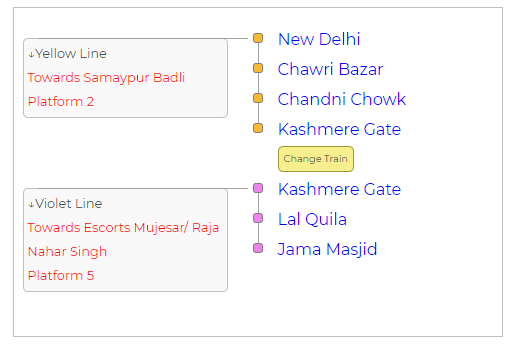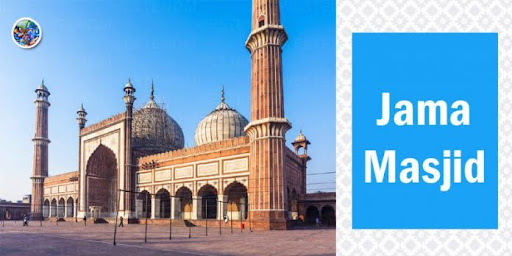Jama Masjid, also known as Masjid-i-Jehan-Numa, is one of India’s Heritage sites, symbolizing a community’s culture, history, and ethos. Even though it is surrounded by the congested alleyways of Old Delhi, numerous foreigners and locals visit it each day to experience the magnificence of this structure. Thousands of Muslims throng the mosque on Eid every year to offer Namaz in the morning.
Shah Jahan spent generously creating this architectural masterpiece. Completing the structure took a staggering ten lakh rupees and 5,000 workers. The construction of the Jama Masjid, which is 80 meters long (261 feet) and 27 meters broad (90 feet), was finished in 1656 AD. Its porch is constructed of red sandstone and stands 9.1 meters (30 feet) above the ground.
Jama Masjid is an Arabic term meaning “world-reflecting.” Hindu and Jain’s architectural traditions influenced the mosque’s construction, as evident in the motifs employed in the mosque’s western part. With an open courtyard of 99 meters (325 ft) with seating for 25,000 people, this mosque facilitates a capacity of 85,000 people! It is considered one of the best Mughal mosques. The mosque has three entrances: north, south, and east.
If you are excited to learn more about this great mosque of Old Delhi, this article is for you. We have covered every detail we know about Jama Masjid in this article.
So, let us explore!
Jama Masjid at a Glance
| Construction Started | 1644 |
| Construction Completed | 1656 |
| Cost Required | 1 Million Rupees |
| Built By | Mughal Emperor Shah Jahan |
| Location | Old Delhi, India |
| Maintained By | Delhi Waqf Board |
| Type | Mosque |
| Dimensions | 80m in length; 27m in width; 41m in its highest point |
| Architectural Style | Islamic |
| Materials Used | Red sandstone and marble |
| Architect | Ustad Ahmad Lahori |
| Capacity | 25,000 |
| Visit Timing | 7am to 12pm, 1:30pm to 6:30pm |
| Entry Fee | Free entry; Rs. 200-300 for photography |
Jama Masjid: Unveiling The Majestic Glory of India’s Symbolic Mosque
Let us now dive deeper into the history, architecture, and some interesting, unknown facts about India’s iconic mosque, Jama Masjid. Also, we will help you know how to get there, the best time to visit, the top things to do, and the delicious food near it.
History of Jama Masjid
A Mughal emperor, Shah Jahan, built Jama Masjid in Delhi to honor his favorite daughter, “Jehan Ara.” She was a devoted Muslim and disciple of Sufi saint Moin Uddin Chishti of Ajmer. The saint led her father out of the grief of his beloved Begum Mumtaj Mahal.
The mosque’s name is derived from an Arabic word, Jummah, referring to the congregational prayer Muslims observe on Friday. It is the final architectural opulence of Shahjahan. The mosque was inaugurated in 1656 by Syed Abdul Ghafoor Shah Bukhari, an Islamic scholar from Uzbekistan.
Ustad Ahmad Lahori designed the mosque but died before the construction started. Later, an architect, Ustad Khalil, completed the architecture with 5,000 workers. The workforce was diverse, including Indians, Arabs, Turks, Persians, and Europeans. Sadullah Khan, a wazir in the reign of Shah Jahan, and Fazil Khan, a comptroller of Shah Jahan’s household, supervised the construction of the Jama Masjid.
Following the British triumph in the 1857 rebellion, Delhi Jama Masjid was seized and used as a military base for five years. The British were eager to bring the mosque down but shelved the plan at the insistence of the local community. Eventually, they agreed to restore it as a place of worship in 1862.
However, during the 1857 protests, the Masjid Madrasa at the southern entrance was destroyed. When the Masjid began to deteriorate, the last Nizam of Hyderabad, Asaf Jah VII, raised funds to rebuild it. He repaired a quarter of the mosque to its erstwhile glory.
The mosque is one of the last monuments by Shah Jahan. It was the royal mosque of the emperor till the end of the Mughal reign. Hence, the mosque is a symbol of Mughal sovereignty with political significance.
Architectural Description of Jama Masjid
The mosque is surrounded by the Zenana Rauza and the Jammat Khana halls from two sides. The walls of Jama Masjid are adorned with inlaid geometric patterns, colorful tiles, and calligraphic inscriptions. The mosque, designed by Ustad Khali, has a magnificent front of eleven arches decorated with marbles. Three projecting galleries separate the minarets, which are dominated by twelve-sided domed pavilions. The expansive central enclosure within the structure is a site for prayer and meditation.
The courtyard is massive, 90X200 feet in diameter. It features a white and black decorated marble floor that mimics a carpet for prayer. The main entrance is on the mosque’s eastern side and is adorned with carved arches and pillars. Mughal-era paintings, inscriptions, and colorfully decorated tiles adorn the arcade walls. There’s a dedicated area for the devout ablutions before prayer at a central pool in the center of the mosque.
How do I get there?
Location
Address: Jama Masjid Rd, Jama Masjid, Chandni Chowk, New Delhi 110006.
The Masjid sits boldly on a plinth in the traditional yet lively market. It is located near Red Fort, which overlooks Mecca in Saudi Arabia.
Hours of operation: 7 am – 12 pm; 1.30 pm – 6.30 pm (daily)
Take the Delhi Metro
By metro, you may reach Delhi Jama Masjid by getting out at the Jama Masjid station, an expansion of the Violet Line. Heritage Line or the Yellow Line can also be opted for to get to Chandni Chowk.
 Take the Bus
Take the Bus
Kashmiri Gate Bus Station is the nearest bus station to Jama Masjid.
Rent a Vehicle
Rent a vehicle and drive down to the mosque, although parking and negotiating the streets of Chandni Chowk may be difficult.
Take a Cab or Use Uber
You may also take a local cab or Uber to Jama Masjid. Check to see if the driver has turned on the meter.
Best Time to Visit Jama Masjid
You are better off visiting the Jama Masjid before noon to skip gatherings and traffic. It is open from 7am to 12pm and 1:30pm to 6:30pm. Prefer not to visit on Fridays, or you will be dealing with gathering for Friday prayers. Also, be attentive to your surroundings during namaz.
How Much Does a Ticket Cost and How to Get it?
Jama Masjid has free entry. However, tourists must pay a fee of 4.22 USD (INR 300) for photography. If you wish to visit the five-story minaret, extra charges will apply.
1. Protocols
When visiting during prayers, avoid passing in front of someone offering namaz, as this is viewed as disrupting, impolite, or breaking the relationship with the divine.
2. Photography
Foreigners must pay an additional $4.22 (300 INR) to snap photographs using their phones or cameras. However, taking photographs should be avoided during prayers.
3. Dress Code
Put on a modest outfit. Both males and females should cover their legs and heads. Also, avoid wearing sleeveless clothes. If you’re unsure what to wear, you can rent a robe at the North Gate. When you get to the mosque’s entrance, remove your shoes. You may carry them in a bag or deposit them at the desk for a fee of $0.14 (10 INR).
4. Scams Targeting Tourists
You may be forced to hire a robe under the pretense of being improperly clothed. You will be provided entry if you adequately cover your shoulders, legs, and head. Some may also insist on paying the camera charge. If you want to climb the minaret for the views, a metal security grill will hinder you, forcing curious tourists to pay the price for the view. Singular female climbers should avoid the tower since it is crowded. The risk of being harassed runs high for them.
Top things to do within Jama Masjid
You might have an endless bucket list to have quality time in Jama Masjid. Here are some significant things you might enjoy at one of the most famous monuments of Delhi.
1. Behold the Towering Minarets
Four towers and two minarets flank the mosque. Both minarets have five stories and stand tall at 40 meters. They are a sight to behold, intricately carved out of red sandstone and marble.
2. View Muhammad the Prophet’s Relics
There’s a cabinet placed at the northern entrance. It’s a treasure trove of relics associated with the prophet Mohammad, which makes it so significant. It features:
- The prophet’s red beard hair
- The prophet’s footprints on a marble slab,
- The prophet’s sandals,
- The Holy Quran is inscribed on the deer’s skin
3. Get a Detailed View of the Entire Old Delhi
You can step into only one minaret. The other is inaccessible to the public. 121 steps lead up to the mosque, with abundant space. You can get a bird’s-eye view of Delhi from the Jama Masjid Minaret.
4. Meet the Other Members of the Masjid.
Several cats at Jama Masjid move from one location to another. Adoring or following them might be a source of entertainment for you. Feel free to feed the hundreds of Pigeons hovering in and around the premises. Eagles might be visible, roaming the endless sky during the dawn, which is a feast for the eye.
Food Near Jama Masjid
When visiting Jama Masjid, foodies will be spoiled for choice. Several popular cafes are nearby to explore some delectable local delicacies.
1. Karim’s
This restaurant has been there since 1913, located near Jama Masjid, opposite Gate 1 in Gali Kasabian. It serves delectable Mughlai food. Try the Mutton Korma, mutton seekh kebab, chicken tikka, and Khameeri roti here! Finish with kheer Benazir (rice pudding).
2. Qureshi
If you are searching for finger-licking kebabs in Delhi, Qureshi is the place. Choose from juicy beef or mutton kebabs that go nicely with silky Rumali Rotis.
3. Aslam Chicken Corner
The chicken tikka with butter curd is a must-try. It is the most famous place in Delhi for chicken tikkas and butter chicken. You will surely forget your calorie count when visiting this place.
4. Al-Jawahar
It is a restaurant inaugurated by India’s first Prime Minister, Pt. Jawaharlal Nehru. It is a few meters away from Jama Masjid, opposite Gate 1. Here, you should try the chicken Jahangiri and the chicken biryani.
5. Kallan Sweets
If you visit Jama Masjid in the evening, you must try tea at Kallan Sweets and feel refreshed. Enjoy with pakoras and samosas. It is the best place for evening snacks.
6. Babu Bhai Kebab Wale
Your heart will melt with Babu Bhai’s extremely soft kebabs. Available at just Rs. 10, you can satisfy your taste buds with delectable kebabs.
Best Things to do near Jama Masjid
Traveling is much more than just sightseeing. Hence, Jama Masjid is not only filled with attractions inside it, but it also has a lot to offer in the environs.
1. Agra Fort
You can witness a section of the Agra Fort. Akbar is credited with the major chunk of the Agra Fort, but his grandson, Shah Jahan, also had a role in its construction. Akbar initially erected the fort to serve as the primary palace of the Mughal monarchy. Shah Jahan brought down parts of the fort’s structures to make way for magnificent white marble palaces and mosques.
2. Gurudwara Sis Ganj Sahib
Gurudwara Sis Ganj Sahib is at a stone’s throw distance from Jama Masjid. The Gurdwara holds a special place for Sikhs, as it is built on a site where Aurungzeb beheaded Guru Tegh Bahadur.
3. Khas Mahal
At a distance of 2 kilometers, you may visit Khas Mahal, which once served as the private palace of the Mughal emperors.
4. Kinari Bazaar
Kinari Bazaar is a wholesale bazaar for decorative laces, borders, and tassels. You will also discover a variety of beads and beadwork products, elegant paper items such as gift envelopes, heavy clothing, adornments for idols and festival decorations, and much more.
5. Urdu Park
If you’re in the area on a Sunday afternoon, check out Urdu Park near Meena Bazaar for a free traditional Indian wrestling event (Kushti). It begins at 4:00 p.m.
6. Meena Bazar
It is a must-visit place near Jama Masjid. The bazaar is well-known for shawls, elegant rugs and carpets, silks and woolens, and many others. This is a perfect place you must visit before winter. Besides, you can find a variety of dresses, sarees, lehengas, kurtis, and readymade clothes.
7. Chandni Chowk
At a distance of 1 kilometer from the Friday Mosque, Chandni Chowk is the oldest market in Old Delhi. It is always busy and chaotic. It has been called the shopper’s paradise since the 17th century.
Interesting Facts about Jama Masjid
Even after many ups and downs, Jama Masjid stands strong as one of the significant monuments of Delhi. And, such a great place ought to have some non-obvious facts.
- Shah Jahan, who built Jama Masjid, used to enter the mosque from the Shahi gate, the mosque’s eastern gate for namaz.
- After Shah Jahan, all Mughal Emperors referred to the Jama Masjid as the Shahi Masjid.
- The steps leading to the gates of Delhi ka Jama Masjid aren’t equal. The steps at Gates 1 and 2 are identically numbered. However, the steps at Gate No.3 are higher. The structure bears a tilt, visible from the entrance of Gate No.2. The tilt is difficult to spot through the naked eye, so you require taking a photograph.
- On gate number 2, essential points regarding the mosque are mentioned.
- Gate number two is Shahi Darwaza, whereas gates one and three are simply referred to as 1 and 2.
- It is estimated that 199 persons can assemble and pray from the marked location inside the mosque.
- There are precisely 69 stairs between the new Meena Bazaar and Jama Masjid’s Gate 2. First, 15 steps, then a landing, 15 more steps, another landing, a broad step, then 31 steps up to the landing in front of the beautiful arch. Finally, four short steps bring you to the courtyard of the Masjid.
- One Paisa was paid to workers during the building, and two Paisas were given to the architect.
- Majorly the workers in the mosque during construction were from Afghanistan and Iran.
- There are no images of Muhammad Prophet in the mosque or any mosque. Most Sunni Muslims think that visual portrayals of all of Islam’s prophets should be forbidden. The primary issue is that the usage of pictures may promote idolatry.
Conclusion
Visiting Jama Masjid would transport you back into history. Not only the mosque but also the streets resonate with history and culture. This lovely haven of peace in the middle of old Delhi is a must-see. Dressing conservatively might not be everyone’s cup of tea, but it will make you feel like a local.
Hope this article will help you make the most of visiting this iconic architecture. It is a cultural, visual, heritage, and religious trip, giving one a chance at a grand feast and shopping.
People are also reading:




